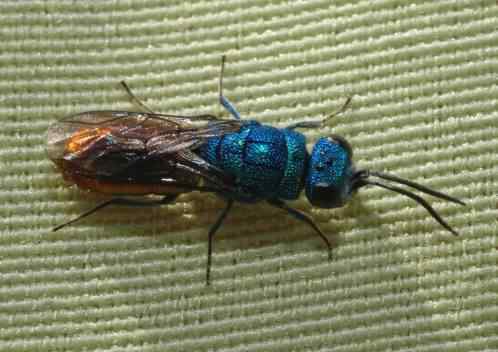
Photo ©2006 Kurt Kulac
Click photo for a larger image
Ruby–tailed Jewel Wasp - Chrysis ignita
Family - Chrysididae
Also known as - Cuckoo Wasp

Photo ©2006 Kurt Kulac
Click photo for a larger image
Found throughout the UK and Europe there are several species of Ruby–Tailed wasps – C. ignita is the one most frequently seen. The head and thorax are a dazzling greenish–blue, and the abdomen is a fiery red. In bright light they have a vivid metallic sheen to the body giving rise to the "Jewel" part of their common name. They are 12–15mm (0.5–0.6in) long and are found in sandy gardens and quarries, heaths and sunlit walls from April to September, essentially anywhere that solitary bees may nest.
They are a parasitoid wasp species laying their eggs in the nests of other solitary bees especially Mason Bees and wasps which are used as a food store by the emerging wasp larvae. For this reason they are sometimes called "Cuckoo Wasps". They remain in the nest until fully developed, emerging the following spring as adult wasps. Once emerged they feed on nectar and pollen living for 9–12 months. C. ignita is one of a number of very similar Ruby–Tailed Wasp species which are difficult to tell apart; Chrysura hirsuta and Chrysis fulgida are classified as Priority Species in the UK Biodiversity Action Plan. Their cuticle has a textured appearance rather like a golf ball, it is very tough and is thought to provide some protection should they be attacked by their host. Some also have a concave abdomen that enables them to roll into a protective ball.
Site design ©1999– Brickfields Country Park - Privacy -